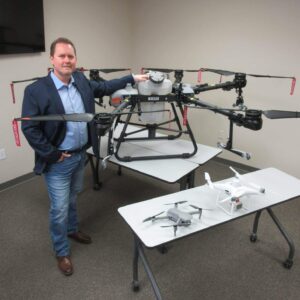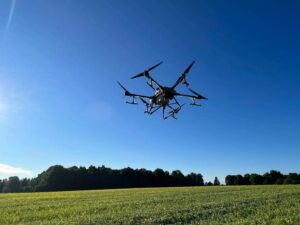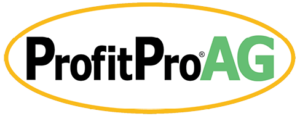Drones Take Spraying, Dry Spreading to the Next Level

When it’s time to spray or spread, how many times is it either too muddy to get into the field, or you can’t get a plane scheduled? What about getting cover crops seeded on time? Forget all that frustration. Things are looking up, thanks to today’s high-tech drones.
These aerial workhorses can literally transcend the limitations of time and space for faster, more flexible in-field applications, from crop protection products and liquid foliar fertilizers to cover crop seeding. Jeramy Williams sees so much promise in drones’ potential to transform agriculture that he switched careers, launched a new business and is teaming up with ProfitProAG to help more farmers benefit from drone technology.
“Every year these drones get bigger and better,” said Williams, the founder and owner of American Drone in Wisconsin. “We’re just at the beginning of this potential.”
Williams, a licensed drone pilot, handled drone applications for Midwest ag clients throughout the summer of 2022. “I truly believe Jeramy’s on the leading edge of taking drone technology to the next level in agriculture,” said John Pernat, a Wisconsin farmer and sales rep for ProfitProAG, which has teamed up with American Drone on aerial
applications throughout Wisconsin and the surrounding areas.
Here are five reasons to consider using drones on your acres:
- Save time and money with precision application. Depending on weather conditions, there’s often only a small window of opportunity for timely applications. While ground rigs can’t run when the ground’s too muddy, for example, that’s no issue for drones. Today’s drones are also larger than ever, covering 30 foot swaths and flying 30 feet per second (20.5 miles per hour). They apply crop protection products exactly when and where they are needed, at the optimum rate, which means more profit potential per acre. “Whether you need to spray a whole field or spot spray, drones provide the options and efficacy you need,” Pernat said.
- Higher yield potential. Did you know you can lose 3 bushels of yield when the sprayer runs over the crop? Considering $6/bushel corn, that’s an extra $18 per acre in your pocket when you prevent this damage, Williams added. He has worked with corn and soybean growers who report yield bumps ranging from 6 to 28 bushels per acre with drone applications. “Drone applications are often much timelier, and there’s no ground rig crushing the plants,” Pernat said. Farmers who chop corn silage have reported a 6 to 15 ton yield increase with the drone, which eliminates corner tucking and crushing, Pernat added.
- No soil compaction. When you don’t have huge sprayers with 120 foot booms rolling over your fields (and sinking into the soil), you avoid compaction.
- Improved safety. Drones fly roughly 12 feet above the crop, which enhances precision application and limits drift. Drones are also safer for the operator, compared to traditional crop dusting. “With traditional aerial application, the plane has to avoid trees, houses and power lines, plus it has to fly back and forth from a local airport,” Williams said. “You don’t have those issues with drones.”
- Beat the labor shortage challenge. It’s getting harder to find trained, skilled applicators to run conventional ground rigs. Drones offer an alternative to help get the work done, Williams noted. “Drones put the control of aerial applications back into the hands of the grower, by allowing them to operate this equipment themselves.”

Understanding drones 101
Maybe you’re wondering, “Should I buy my own drone or contract with a commercial applicator?” “There’s more to it than people think,” Pernat said. “Buying a drone is not just like buying a new or used car, and off you go. There are specific rules and regulations you need to follow.”
Just ask Williams, who learned all the steps involved as he built his American Drone business. Raised on a dairy farm in central Wisconsin, Williams graduated from the Milwaukee School of Engineering with a mechanical engineering degree. During his career, he worked with factory automation systems and also became interested in aviation as a hobby, earning his pilot’s license in 2005.
When he experienced career burnout, he knew it was time to pivot. “I thought about ways I could combine my farming background, my technology/engineering skills and my interest in flying,” he said.
Williams gravitated towards building a crop-dusting business. He was close to launching this business with a partner who managed the Waukesha, Wisconsin, airport. The more Williams thought about it, however, the more reservations he had.
“In aviation, altitude is life insurance, meaning the higher up you are, the more time you have to make decisions if something goes wrong,” he said. “With crop dusting, however, you’re flying 150 miles per hour, 20 feet off the ground.”
As Williams weighed his options, he considered the fact that drone technology had advanced to the point where it could offer practical solutions for agriculture, especially with spraying.
“I know it’s difficult for co-ops to find aerial applicators,” he said. “I could also see that these bigger, faster drones could be much safer than traditional aerial application.”
That’s when Williams decided to become a fully licensed drone pilot and launch American Drone. After creating his new company, he provided application services to a number of ag cooperatives and individual farmers throughout the summer of 2022.
ProfitProAG provides agronomy expertise
While Williams understands drone technology and drone operator licensing requirements, he’s the first to admit he’s not an agronomist. “That’s why I work with ProfitProAG.”
Pernat has seen first-hand how Williams’ drone services live up to their promises. “Once farmers try a drone, they’re sold on it,” said Pernat, who raises corn, soybeans, hay, wheat and small grains, in addition to working as a ProfitProAG sales rep. “One of the farmers we work with won’t go back to a ground rig after using the drone.”
ProfitProAG’s “drone recipe” typically includes:
- BioEnergy™+. This foliar feeding system provides energy, nutritional and stress mitigation support to a developing crop. This helps maximize plants’ ability to overcome in-season stresses and maximize the crop’s genetic potential (both yield and quality). BioEnergy+ also includes an ethylene inhibitor. When plants become stressed, they produce ethylene. These gaseous molecules regulate many diverse processes throughout the plant’s life cycle, from seed germination to leaf growth to reproduction. “Crops ‘stall out’ with too much ethylene, which can harm plants’ growth and development,” Pernat said.
One of the best examples of ethylene’s effects occurs when you put a banana in a brown paper bag. The ethylene is trapped in the bag and ripens the banana. With crops, some studies suggest that ethylene shuts down leaf growth quickly after a plant senses stress, such as limited water availability. This curtails maximum photosynthesis, which hurts yield potential. The ethylene inhibitor in BioEnergy+ hinders the plant’s ability to produce ethylene, so the plant can continue to grow, develop and produce a higher yield. - BioImpact™+. This product improves the performance and vigor of your plants and extends the growing season of your crops. A key component of BioImpact+ is chitosan, a non-toxic, biodegradable product derived from one of the most abundant organic polymers in nature. Chitosan targets chitin, the main component of insects’ exoskeletons. Harmful fungi and disease pathogens also contain chitin. Chitosan helps break down chitin for greater insect and disease suppression, which promotes healthier crops.
Williams uses a blend of products (BioEnergy+ at 1 qt/A and BioImpact+ at 1 pt/A and half rate of a fungicide) and water applied via drone. Farmers have reported yield bumps up to 28 bushels per acre with these drone applications. “Let’s say you invest $20 in the drone application, plus another $27 for products,” Pernat said. “You’re at $47 cost per acre. 28 bushels per acre x $6.00 per bushel corn equals a $168.00 advantage per acre, minus the cost or $47.00/acre equals a $121.00 per acre advantage. Even a 20 bu per acre increase would give us a $73.00 per acre advantage. The drone application certainly pays for itself.”
The benefits don’t stop there. “With the ProfitProAG recipe and drone application, you can use fewer ‘cides’ of all kinds—insecticides, fungicides, herbicides, etc.,” Pernat said. “This helps you build a healthier soil biome, use fewer chemicals and get more out of your crop. It’s a win-win-win.”
How can I put drones to work on my farm?
So the question remains: should you choose custom application with a drone, or own your own drone? ProfitProAG and American drone can help you ask the key questions to determine the right option for your farm.
“Jeramy is an applicator first, plus he’s a drone sales/service professional, so he’s a great resource,” Pernat said.
For farmers who want to purchase their own drone, American Drone provides options for equipment and training on how to use the drone for liquid and dry aerial applications.
“If you want to own and fly your own drone, we make sure you’re legal, safe and accurate,” said Williams, who partnered with conservation groups to seed 30,000 pounds of cover crop seed in 2022. “When you own your own drone and get the required licenses, this can also create opportunities for you to do custom work for farmers in your area.”
Some growers prefer to have American Drone provide custom applications for their acres, added Williams, who works with customers in Wisconsin and nearby states. “About half of my clients buy a drone, and about half hire American Drone for custom work,” he noted.
Questions? Contact ProfitProAG today to learn more about how we can connect you with American Drone and put this tremendous potential to work on your acres.
